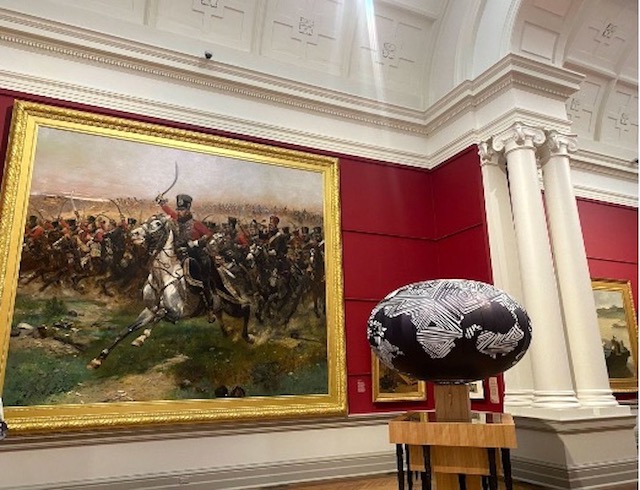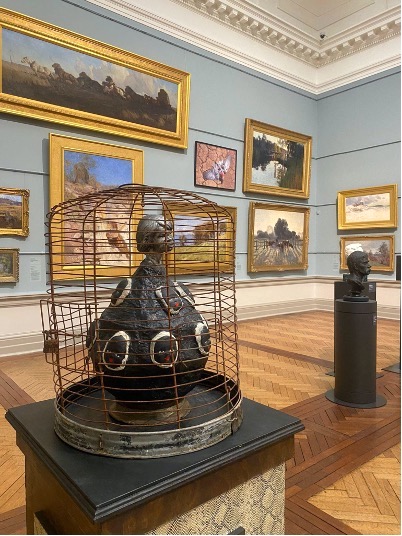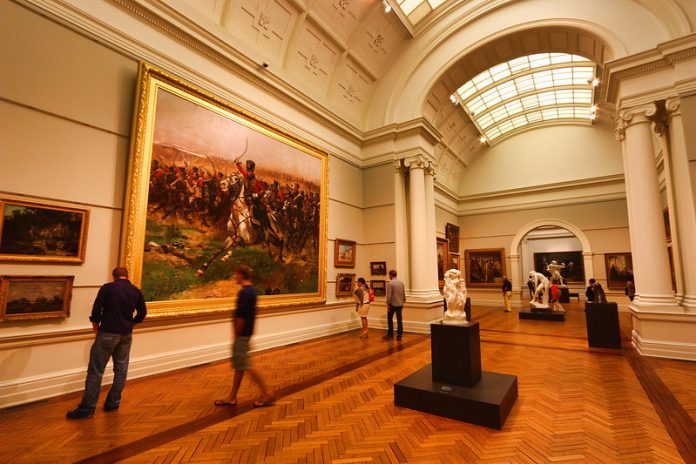It’s a warm Sunday in October, and I’m visiting the Art Gallery of NSW. The loud hustling of the city outside is replaced by the gentle murmur of the weekend crowds shuffling throughout the exhibition spaces. I turn for the Grand Courts on my right, their tall arches welcoming me in. The clear influence of the Victorian era manifests in the distinctly European architecture of stately columns and decorative roofing, the space adorned with marble figures and European artworks bound by ornamental gold frames. It reflects what the architects wanted to create in 1871; ‘A Temple for Art’.
But this time there is something different about the space. First Nations artworks, as well as contemporary works from across the globe, are now dispersed amongst the traditional European and colonial works housed here for the past half century.
The narrative of the curators has changed, and a recent ‘rehang’ of the collection in late 2021 has made an attempt to rewrite a more inclusive image of the art world. The artworks are now immersed in moments of connection and reflection, encouraging conversations between past and present, Indigenous and non-indigenous art.
It was in a zoom class during lockdown last year that I first began to think about the museum as a place of constructed stories and carefully written histories.
It was late in the semester, and attendance had begun to dwindle among the onslaught of assessments and exams. The tutor spoke enthusiastically to a class of faceless names, his eagerness for participation drowned out by the silence of muted students. It wasn’t a particular quote from him that I can pinpoint that caught my attention, but this conversation that began to emerge about the role of the gallery in creating stories. Stories about history, about religion, about the relationships between humans. Like authors, the curators were able to make us see things how they envisioned them, each artwork a building block in the gallery’s ‘narrative’.
Tianrui Yu writes in their musings on curated stories for the Columbia Oral History Arts Journal how narratives are created in such a way that “can manipulate, guide and direct the audiences to think or react in a desired way”, achieved through “decisions about hiding or highlighting parts of a whole story”.
Curated stories are powerful in shaping how we view art – what context we see it in, its location and its relationship to other work can all elicit a specific interpretation that can be nuanced, but inadvertently can elevate one perspective over another.
I have always loved visiting art galleries. As someone studying Art History at the University of Sydney, I appreciate how seeing art can really make you feel something, see something, or understand a world unknown. Art connects us not only to other people, but to other places and other times. A painting, a sculpture or a film can provide some kind of solace; a chance to be comforted in our known ways or to be projected into an unknown space of discovery and wonder.
The danger lies in what art the gallery shows us, or perhaps what they don’t. A single curated narrative can fashion ideas that are narrow in scope, or dangerous to the development of an all-inclusive society. Chimamanda Ngozi Adiche, in her lecture ‘The Danger of a Single Story’, suggests that “how stories are told, who tells them, when they’re told, how many stories are told, are really dependent on power”.
Looking at the gallery, the influence of a Western colonial power on its storytelling is undeniable. The Victorian-inspired building itself is a stark reminder of Sydney’s colonial past, while the traditional displays reflect a preference given to Euro-centric art. The Heidelberg School works of Tom Roberts, the Impressionist works of Monet and Cézanne or the classically beautiful marble figures of antiquity all sit comfortably within the Western art history canon.
The static nature of the collections has meant that up until this rehang, the Art Gallery of NSW had been curated with a particular narrative focus, whether intentional or not. The structure of the museum was clearly defined: the European and Colonial works were on the first floor, sitting among the grandeur of the Courts while art from ‘other’ worlds was held separate. My tutor spoke of the physical connotations of the art’s location – the European works were literally ‘above’ First Nations art or art from different cultures around the globe.
The power to create this story is a power that can be used to curate another.
Now, walking into this new imagined and immersive space, I feel engulfed in a new inclusive story that attempts to bring a more rounded worldview of the art, both for the art history experts that frequent the gallery and the casual tourists. Gallery director Dr Michael Brand talks of this ‘rehang’ as a “thorough rethinking of how our collections are displayed and experienced”. It is an event of reimagining, rebranding and reinstating the image and character of the collections.
The inconsistency that persists as I wander from room to room excites me at every turn. The contrast between these repositioned works successfully creates an effective story that tackles a broad range of themes: war and its consequences; relationships with landscape; and realities of race, gender and class, as well as complex issues such as post-colonialism and ownership, are explored in a space of converging identities, cultures and representations.

In front of me, French artist Edouard Detaille’s magnificently large Vive l’Empereur! (1891) takes up an entire wall of the gallery. An icon of the Grand Courts (having been purchased by the gallery from Paris in 1893), the painting recaptures the terrifying drama of a charge of the 4th Hussar Regiment in the Napoleonic period. It is a heroisation of the European military, in this case the French, and with its scale creates an almost divine and worshipped image of European conquest and invasion.
But instead of existing on its own as it has in the past, the grand painting is now obscured by a wooden cabinet-like structure and round inflated globe. First Nations artist Brook Andrew’s Tombs of Thought: Earth (2017) occupies the viewing space that the painting had once consumed, bringing it into conversation with questions on the dominant accounts of history and the legacy of colonialism in the gallery.
The interdisciplinary work creates an ongoing subversion of Western museum display conventions, Andrew’s ‘Cabinet of curiosities’ containing images, books and objects from the gallery’s archives that point to the institution’s predominantly colonial worldview in its foundational years. Now, 150 years on, with the gallery’s acknowledgement of its role in the process of reconciliation, the sculpture creates a conversation on these layered histories. The dual display harbours a new story interweaving the relationships between First Nations art and colonial art.

The large inflatable elements of Andrew’s work also directly interact with the large-scale military painting on ideas of conquest and military expansion. These large ball inflatables scattered across the courts feature black and white graphic patterning adapted from Wiradjuri shield designs and carvings. They resemble giant globes, seemingly proposing a new world order that has advanced out of European dominion into a post-colonial society.
In the past curated ‘narrative’ of the gallery, these two works would have existed, and been interpreted, separately. Now, in the same space, a new dimension of interpretation is brought to light, and the narrative of the curators provides a more rounded story to be imagined and engaged with.
Further contrasts include Karla Dickens’ found object sculptures that unashamedly criticise historical mistreatment of Indigenous performers, offset against a backdrop of calm and peacefully rendered colonial landscapes. The stark contrast is jarring to the eye. Rather than seeing the works separately, the fact they exist in the same period, in the same place, provides a confronting understanding of the extremities to which European and First Nations experiences differ. If we were to view them apart, this sharp contrast would not be so apparent.
Now I realise that when viewing these pieces of art together, the experience becomes much more enriching. I’m no longer looking at one singular place or one singular point in time but seeing a conversation across vastly different and converging aspects of art history.
The power of the curatorial narrative is at play, and this new story is one that may not be perfect but provokes thought and progression for contemporary art historical discourse.
Wandering from court to court, there is a new contemporary attitude to art history blossoming. Artworks from across time and place are immersed in a sea of converging and conversational perspectives, overwhelming at times but crucial to forming this new understanding of the art history canon.
Standing in the middle of the large court, I am immersed in a new narrative, in a new world of art.


